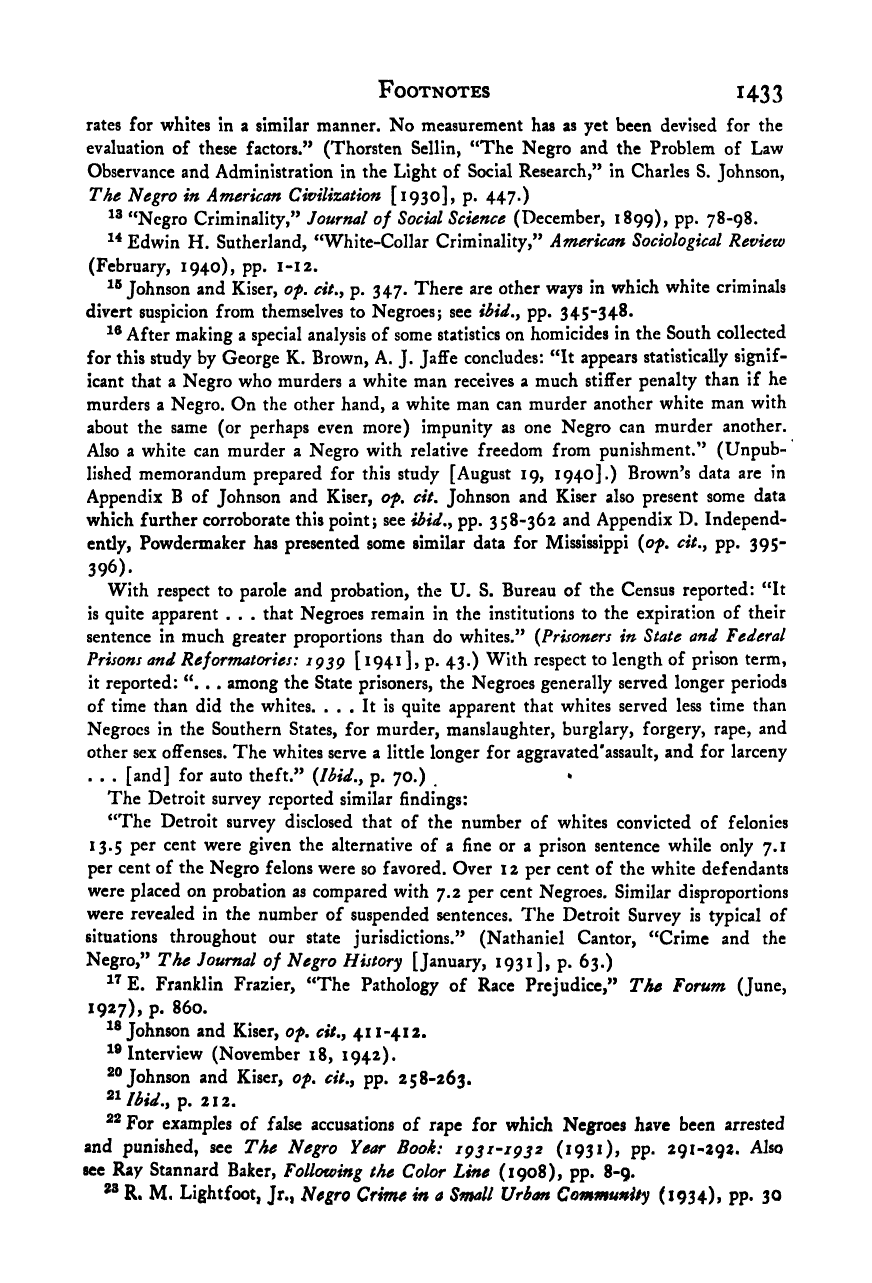Note: Gunnar Myrdal died in 1987, less than 70 years ago. Therefore, this work is protected by copyright, restricting your legal rights to reproduce it. However, you are welcome to view it on screen, as you do now. Read more about copyright.
Full resolution (TIFF) - On this page / på denna sida - Footnotes - Chapter 44

<< prev. page << föreg. sida << >> nästa sida >> next page >>
Below is the raw OCR text
from the above scanned image.
Do you see an error? Proofread the page now!
Här nedan syns maskintolkade texten från faksimilbilden ovan.
Ser du något fel? Korrekturläs sidan nu!
This page has never been proofread. / Denna sida har aldrig korrekturlästs.
Footnotes 1433
rates for whites in a similar manner. No measurement has as yet been devised for the
evaluation of these factors.” (Thorsten Sellin, “The Negro and the Problem of Law
Observance and Administration in the Light of Social Research,” in Charles S. Johnson,
The Negro in American Civilization [1930], p. 447.)
13
“Negro Criminality,” Journal of Social Science (December, 1899), PP* 78-98.
Edwin H. Sutherland, “White-Collar Criminality,” American Sociological Review
(February, 1940), pp. 1-12.
Johnson and Kiser, of. cit.^ p. 347. There are other ways in which white criminals
divert suspicion from themselves to Negroes; see ibid.^ pp. 345-348.
After making a special analysis of some statistics on homicides in the South collected
for this study by George K. Brown, A. J. Jaffe concludes: “It appears statistically signif-
icant that a Negro who murders a white man receives a much stiffer penalty than if he
murders a Negro. On the other hand, a white man can murder another white man with
about the same (or perhaps even more) impunity as one Negro can murder another.
Also a white can murder a Negro with relative freedom from punishment.” (Unpub-
lished memorandum prepared for this study [August 19, 1940].) Brown’s data are in
Appendix B of Johnson and Kiser, of. cit. Johnson and Kiser also present some data
which further corroborate this point; see ihid.^ pp. 358-362 and Appendix D. Independ-
ently, Powdermaker has presented some similar data for Mississippi {of. cit.^ pp. 395-
396).
With respect to parole and probation, the U. S. Bureau of the Census reported: “It
is quite apparent . . . that Negroes remain in the institutions to the expiration of their
sentence in much greater proportions than do whites.” {Prisoners in State and Federal
Prisons and Reformatories: ig$g [1941 ]» p» 43-) With respect to length of prison term,
it reported: “. . . among the State prisoners, the Negroes generally served longer periods
of time than did the whites. ... It is quite apparent that whites served less time than
Negroes in the Southern States, for murder, manslaughter, burglary, forgery, rape, and
other sex offenses. The whites serve a little longer for aggravated’assault, and for larceny
. . . [and] for auto theft.” {Ibid.y p. 70.) •
The Detroit survey reported similar findings:
“The Detroit survey disclosed that of the number of whites convicted of felonies
13.5 per cent were given the alternative of a fine or a prison sentence while only 7.1
per cent of the Negro felons were so favored. Over 12 per cent of the white defendants
were placed on probation as compared with 7.2 per cent Negroes. Similar disproportions
were revealed in the number of suspended sentences. 7’he Detroit Survey is typical of
situations throughout our state jurisdictions.” (Nathaniel Cantor, “Crime and the
Negro,” The Journal of Negro History [January, 1931], p. 63.)
E. Franklin Frazier, “The Pathology of Race Prejudice,” The Forum (June,
1927), p. 860.
Johnson and Kiser, of. cit.y 41 1-412.
Interview (November 18, 1942).
Johnson and Kiser, of. cit.y pp. 258-263.
Ibid.y p. 212.
For examples of false accusations of rape for which Negroes have been arrested
and punished, see The Negro Year Book: jpjj-zpja (1931), pp. 291-292. Also
see Ray Stannard Baker, Following the Color Line (1908), pp. 8-9.
R. M, Lightfoot, Jr., Negro Crime in a Small Urban Community (1934), pp. 30
<< prev. page << föreg. sida << >> nästa sida >> next page >>